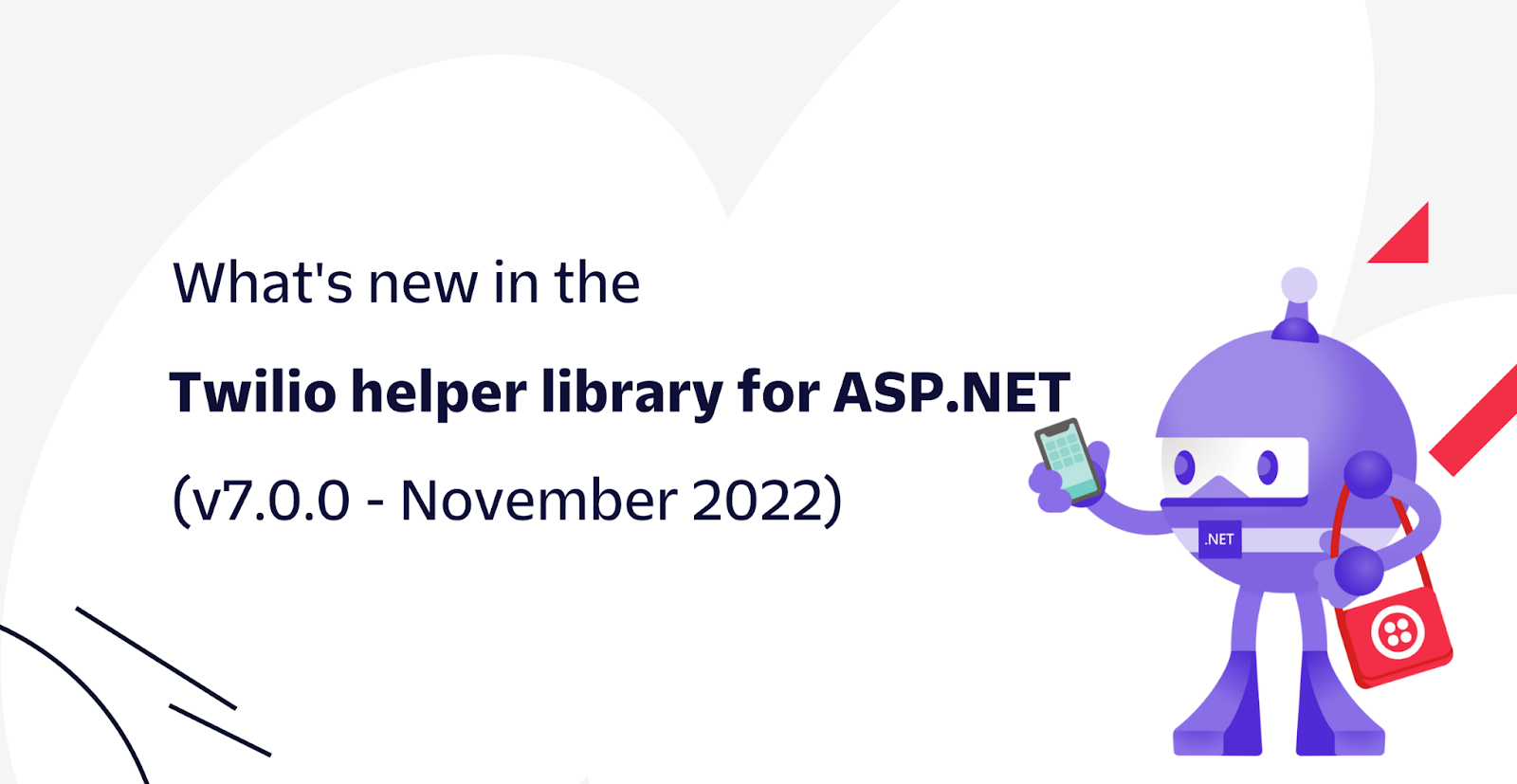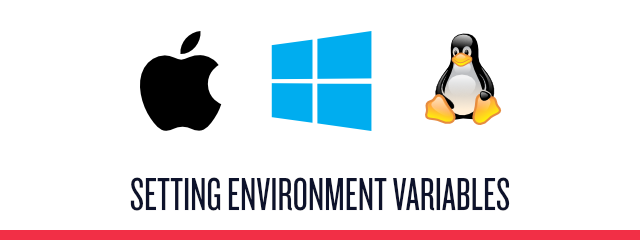What's new in the Twilio helper library for ASP.NET (v7.0.0 - November 2022)
Time to read:

The Twilio helper library for ASP.NET (Twilio.AspNet) is a community-driven open-source project to make integrating Twilio with ASP.NET easier, for both ASP.NET Core and ASP.NET MVC on .NET Framework. The library helps you achieve common use cases and with the release of version 7, we're expanding the library's capabilities and improving existing features.
What's new in Twilio.AspNet v7.0.0
V7.0.0 is a major release of the Twilio.AspNet library because it contains breaking changes.
Here's an overview of the changes:
🎉 NEW FEATURES
- You can now use the
ValidateTwilioRequestFilterto validate that HTTP requests originate from Twilio. This adds validation to endpoints including Minimal APIs. - You can also use the new
ValidateTwilioRequestMiddlewareto validate Twilio requests for when you can't use the[ValidateRequest]attribute or theValidateTwilioRequestFilter. - There are new overloads for the
TwiMLResultconstructor and for theTwiMLmethods that let you specify how to format the TwiML in the HTTP response body. This lets you remove whitespace to minimize the payload size. - The
VoiceResponseandMessagingResponseclass has a new extension methodToTwiMLResult()that will create aTwiMLResultfor you.
🙌 ENHANCEMENTS
- The
SmsRequestandVoiceRequestclass has been updated with parameters that were missing. Twilio.AspNet.CoreandTwilio.AspNet.Mvcnow depend on version 6 of the Twilio C# helper library.
⚠️ BREAKING CHANGES
- You can no longer pass in a
stringorXDocumentinto theTwiMLResultconstructor. You can find guidance on how to update your code in this GitHub Gist. - The public properties on
TwiMLResulthave been removed. - The
HttpRequest.IsLocal()extension method has been removed. - The
HttpStatusCodeResultclass has been removed in favor ofStatusCodeResultprovided by ASP.NET Core MVC andHttpStatusCodeResultby ASP.NET MVC on .NET Framework. - The
Twilio.AspNet.Core.MinimalApinamespace has been removed. Types from the namespace have moved to theTwilio.AspNet.Corenamespace. - The
RequestValidationHelperclass is now static. You'll need to change your code to not instantiate this class and call its methods in a static manner instead.
Validate Twilio requests in endpoints and minimal APIs
To integrate with Twilio webhooks, your webhook handlers have to be publicly accessible on the internet. That means everyone else can access your webhook handlers – including malicious actors. This is why you have to validate that the incoming HTTP request originates from Twilio.
The helper library for ASP.NET has multiple ways to perform this validation. First of all, you need to configure Twilio request validation by calling .AddTwilioRequestValidation() during startup:
Then you need to use .NET configuration to configure the request validation. Here's the JSON representation of the configuration:
Now that request validation is configured, you can apply the [ValidateRequest] attribute to your controllers and actions in ASP.NET Core MVC. However, until now, there was no way to validate requests outside of MVC. In v7 there are two new ways to validate requests outside of MVC, using the ValidateTwilioRequestFilter for endpoints and Minimal APIs, and using the ValidateTwilioRequestMiddleware which is discussed in more detail later.
Here's how you can add request validation using the new ValidateTwilioRequestFilter:
Before the /sms endpoint is executed, the ValidateTwilioRequestFilter will validate that the HTTP requests originate from Twilio.
ValidateTwilioRequest() is a convenience extension method and is the equivalent of the following code:
ASP.NET Core 7 also introduced endpoint groups, which you can also apply the request validation to:
Now HTTP POST requests going to /twilio/sms and /twilio/voice will first be validated by the ValidateTwilioRequestFilter.
Validate Twilio requests using middleware
If you can't use the [ValidateRequest] attribute or the new ValidateTwilioRequestFilter, you can now plug the ValidateTwilioRequestMiddleware into your request pipeline. Keep in mind that the middleware will run for all HTTP requests unless you conditionally apply the middleware using MapWhen or UseWhen.
The ValidateTwilioRequestMiddleware is particularly useful for serving static media files that only Twilio should have access to, because middleware is the only way to hook into the HTTP requests for static files. Here's how you would serve static files with Twilio request validation:
The ValidateTwilioRequestMiddleware is added by the app.UseTwilioRequestValidation() extension method. However, this middleware only runs when the path of the incoming HTTP request starts with /twilio-media because it is conditionally added using app.UseWhen.
The media files are stored in a subfolder called TwilioMedia and served at the path /twilio-media. When those media files are requested, the ValidateTwilioRequestMiddleware validates the HTTP request before returning the file. However, other HTTP requests are unaffected.
Remove whitespace from your TwiML response
There are now overloads for the TwiML methods and the TwiMLResult constructor that let you specify the formatting of the TwiML using the System.Xml.Linq.SaveOptions enum. By specifying SaveOptions.DisableFormatting, there will be no formatting for the TwiML written to the HTTP response body. This will remove the whitespace and indentation from the resulting XML.
Here's an example of this using Minimal APIs:
The response body would normally look like this:
However, with formatting removed, the response body looks like this:
The ToTwiMLResult() extension method
The ToTwiMLResult() method extends the MessagingResponse and VoiceResponse classes, so you can more fluently create a TwiMLResult.
Here's how you'd create a TwiMLResult in Minimal API without ToTwiMLResult():
This is the same code using the ToTwiMLResult extension method:
The ToTwiMLResult() also works in ASP.NET Core MVC.
Go use the shiny new bits
You can take advantage of these new features and enhancements now by installing the latest version of the Twilio helper library for ASP.NET. You can find the installation instructions in the readme of the Twilio.AspNet GitHub repository. If you like this library, consider giving it a star on the GitHub repo. Also you are welcome to submit an issue if you run into problems.
We can't wait to see what you'll build with Twilio.AspNet. Let us know on social media and don't forget to mention @TwilioDevs and @RealSwimburger on Twitter or LinkedIn.
Niels Swimberghe is a Belgian American software engineer and technical content creator at Twilio, and a Microsoft MVP in Developer Technologies. Get in touch with Niels on Twitter @RealSwimburger and follow Niels’ personal blog on .NET, Azure, and web development at swimburger.net.
Related Posts
Related Resources
Twilio Docs
From APIs to SDKs to sample apps
API reference documentation, SDKs, helper libraries, quickstarts, and tutorials for your language and platform.
Resource Center
The latest ebooks, industry reports, and webinars
Learn from customer engagement experts to improve your own communication.
Ahoy
Twilio's developer community hub
Best practices, code samples, and inspiration to build communications and digital engagement experiences.


